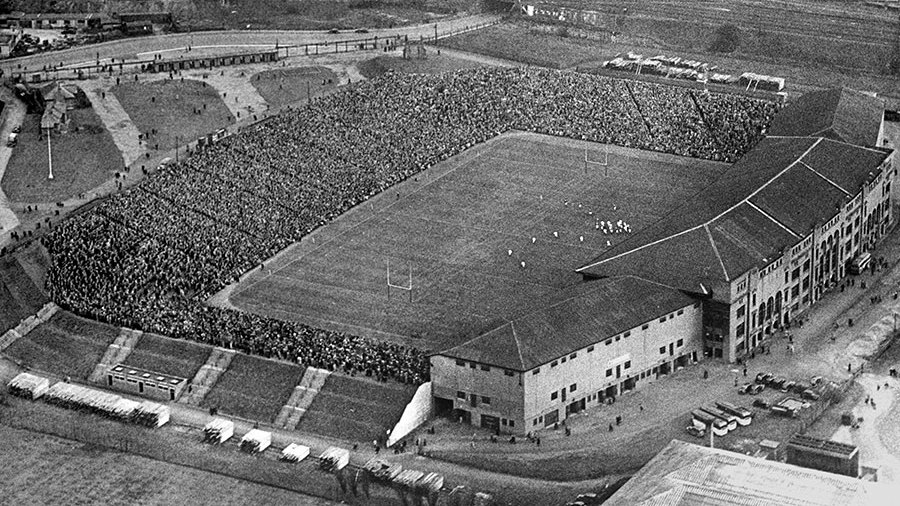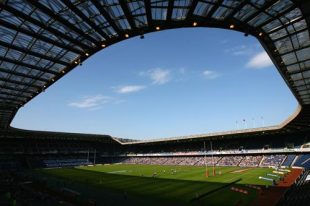|
Rewind to ... 1925
Rewind to 1925: Murrayfield's stellar debut
Huw Richards
March 19, 2015

An aerial view of Murrayfield during its early years, having opened to acclaim in 1925 © PA
Enlarge
Maybe the anthems before Saturday's Scotland v Ireland match should be supplemented by 'Happy Birthday To You', since it is also the day when Murrayfield turns 90. The very first match ever played there was on March 21, 1925, a Calcutta Cup clash with England. The Scottish Rugby Union, a more imaginative body than its reflexive conservatism on some matters suggested, had concluded some years earlier that they needed a better ground than their existing stadium at Inverleith, and in 1922 purchased land previously owned by the Edinburgh Polo Ground. There they constructed a new stadium, featuring a grandstand reported by The Times as "second to none in the world of sporting spectacles" and massive terraces. It was, as player-turned-writer Jock Wemyss recalled "the boast of the SRU that the gates at Inverleith (capacity 25,000) were never closed. The public saw to that by staying away". By contrast, "spacious Murrayfield made an irresistible appeal, with consequences happily never repeated". Wemyss's account of Murrayfield's first day has unmistakeable echoes of events two years earlier at the opening of that other vast, supposedly sufficient-for-all-needs 1920s sporting colosseum, Wembley Stadium.
Fans came to the new ground in unprecedented numbers. "The public were badly 'packed': the gates were closed, thousands were turned away; many hundreds ran round the great embankment unable to gain even a glimpse of the pitch: a great crowd of demonstrators behind the stand demanded their money back or admission to the enclosure. Eventually they were allowed through the players' entrance under the stand and accommodated around the touchlines." It wasn't just the new stadium that attracted them. It is possible that the first match ever staged by Murrayfield was also the greatest. It matched arguably the best - and almost certainly the most exciting - Scotland XV with an England team whose sustained excellence matched any team in Five/Six Nations history. Scotland had scored 16 tries, including eight from wing Ian Smith, in their previous three matches. England had not lost to Scotland since 1912, and very little to anyone else. That entire period of seven seasons - five more had been lost to the war - had produced five Grand Slams and only two defeats, remarkable hammerings inflicted by Wales at Swansea in 1920 and Cardiff in 1922. England were unbeaten in their last 13 championship matches, and another win would give them an unprecedented hat-trick of outright titles. It was to be a titanic struggle, played out, according to Wemyss, "on beautiful turf which had never been torn by a swinging maul or cut up by players' studs". William Luddington of England claimed the first points with a penalty goal, but the first try was scored by Scottish scrum-half Jimmy Nelson, who formed a Glasgow Academical half-back pairing with partner Herbert Waddell which attracted less attention than the Scots' all-Oxford threequarter line, but was no less important. Full-back Dan Drysdale converted and Scotland led, but not for long. The rumbustious Tom Voyce drove for the Scottish line and created space for pacy wing Richard Hamilton-Wickes to cross. Luddington's conversion made it 8-5 at half-time. That lead was extended not long after half-time when England captain Wavell Wakefield crossed, but the conversion failed under strange circumstances - there was a brief misunderstanding between Luddington and the England player placing the ball, then a required element in every kick at goal, and Scottish forward David McMyn raced from behind the goal-line to kick it away. Inspired by the let off, and the fear of seeing a great season fizzle out, the Scots attacked and wing Johnny Wallace was sent careering down the touchline for a score which made him the first man to cross in every match in a season. No.8 Sandy Gillies converted and the gap was down to a point. Scotland continued to attack. With a few minutes to go Waddell narrowly missed with a drop-kick, but was presented with a similar opportunity within little more than a minute and this time hit the target for a score then worth four points, and Scotland led 14-11. With five minutes to go England attacked furiously. Their New York-born outside-half Edward Myers (typical of a cosmopolitan contest in which three of the Scottish threequarters were antipodean-born and England's pack included Roderick MacLennan, a Gaelic-speaking Scot whom the harrumphing EHD Sewell would say many years later "had no more qualification for England than Goebbels has to bat for Yorkshire") was halted at the line, centre Len Corbett broke through and fell through sheer exhaustion and, after a brutal melee in which Drysdale was kicked in the head, England full-back 'Tosh' Holliday was inches wide with a last-minute drop-goal attempt which would have won the match by a single point.

Murrayfield as it is now - a modern, 67,500-capacity all-seated stadium
© Getty Images
Enlarge
An exultant Glasgow Herald warned that 'It will be the duty of Scotland sides in future years to confirm the Murrayfield precedent'. But it took some confirming. It would be 59 years before Scotland added a second Grand Slam to the one won on their first day at Murrayfield. One reason was that while England had fallen at the first attempt at Murrayfield, Ireland found it far more hospitable. Their Irish won 3-0 on their first visit in 1926, did not lose until 1934 and in all won 15 of their first 20 visits to Murrayfield. The Scots have regained some ground since, but five consecutive wins from 2003 to 2011 have made Ireland the only Six Nations visitor to have won more than they have lost there, by 22 wins to 18. Yet the Scots have enjoyed more success at Lansdowne Road than at any other away venue. While less remarked upon than their Twickenham jinx, Scotland's poor record at home to Ireland means they face an almost insuperable handicap every other season, since the scheduling means that their two least favourite fixtures happen, as in 2015, in the same year. This year is the 42nd in which Scotland have played England at Twickenham and Ireland at Murrayfield. Only once, in 1938, have they won both matches. Ireland would doubtless still on balance prefer to be chasing the title in Dublin . And Joe Schmidt has been warning of the risk of underestimating Scotland for several weeks. But if history is any guide - and in the Six Nations it often is - there is nowhere else Ireland would rather be this weekend than Murrayfield. © ESPN Sports Media Ltd
| |||||||||||||||
Live Sports
Communication error please reload the page.
-
Football
-
Cricket
-
Rugby
-
- Days
- Hrs
- Mins
- Secs
F1 - Abu Dhabi GP
Abu Dhabi Grand Prix December 11-131. Max Verstappen ()
2. Valtteri Bottas (Mercedes)
3. Lewis Hamilton (Mercedes)
4. Alexander Albon ()
5. Lando Norris ()
6. Carlos Sainz Jr ()
-
ESPNOtherLive >>
Snooker - China Open
Tennis - Miami Open

